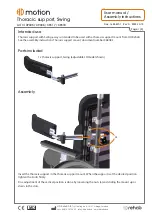
Safety Alarm Unit & Sensor Pad
Mounting Bracket
Continued on reverse side
LED
A
C
B
Reorder#
Description
Unit
909367
ChairPro Alarm Unit
Each
909366
ChairPro Alarm Unit
10/pk
Status
Condition
On Steady
No sensor installed, battery installed
Slow Flash
Sensor connected, battery installed
Rapid Flash
Sensor connected, alarm activated
Light Sensor Conditions
Features:
•
Low battery alert
- alarm sounds when battery is low
•
Sounds
- two tone buzzer, high (90db), low (80db)
• Battery Test
• Auto-Reset
• Two Interfaces (connections) - Modular (telephone type) for flat
sensors and mini-plug for alternative sensors
• Cable strain relief
• Shock resistance bumpers
1.
Remove battery compartment cover on back of alarm unit and install two AA batteries, LED will light, steady.
2.
Press “Battery Test” button. If alarm doesn’t sound check battery connection and retest.
If alarm fails to sound replace battery.
a. This alarm has a low battery alert and an alarm will sound during a “low battery condition”.
3.
Insert telephone type plug into modular connection on the side of the alarm
(Illustration A). Thread the cord through the “Cable Stain Relief” cavity as shown in (Illustration B)
LED will flash. Make sure that there is some slack so that if the cord is tugged it doesn’t put pressure
on the connector. Alarm will sound. Press “Auto-Reset” button to silence alarm.
4.
Before using, test unit by pressing the palm of your hand firmly against the sensor pad.
While doing this, check alarm to make certain that LED is flashing. Remove your hand.
Alarm should sound. Press “Auto-Reset” button to silence alarm. If alarm fails to sound,
make certain the telephone type plug is secure.
5.
Select High or Low alarm volume using the switch on right side of alarm, and select Tone 1 or 2
6.
When alarm is activated by the resident leaving the wheelchair, it maybe silenced by pressing the
“Auto-Reset” button. The alarm is now in stand-by mode. The system will automatically go into the
monitoring mode when the resident is reseated.
There is no on/off switch.
Safety Reminders
1.
Check battery before each use. If alarm is
weak or fails to sound, replace the
two AA batteries.
2.
When unit is in use, check LED regularly.
If it is not glowing, replace the two AA batteries.
You may choose one of the three methods to attach the alarm unit to the wheelchair
Mounting Bracket
1.
Remove the second-from-top screw from either the left or right side of the
wheelchair backrest (other locations may be chosen by the caregiver).
2.
Remove grommet from screw, place the screw through hole on alarm unit
mounting bracket, and fasten screw (with the grommet) to wheelchair backrest (Illustration C).
OPERATION
INSTALLATION
Condition
Alarm sounds
when resident stands
Alarm sounds
when sensor plug is removed, while resident’s sitting on sensor
Alarm sounds
when sensor pad wire (grey) is cut, while resident is sitting on
sensor. Alarm does not sound when auxiliary wire (black) is cut
Alarm sounds
when batteries are low
Alarm Conditions
Note:
The alarm will not sound when the sensor pad wire (grey) is cut or accidentally pulled out unless it is
activated. Also, when the sensor is activated by a resident sitting on it and the plug is accidentally pulled
out it will ring but when re-inserted, the alarm will stop ringing. All of the conditions above apply either to the
telephone type plug or mini-plug. The alarm sounds only when the mini-plug (black) is removed while sensor
is activated. It will not ring when this wire is cut.




















